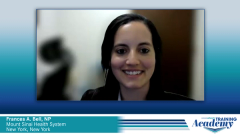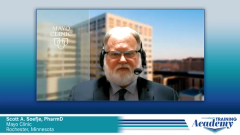
Pharmacists’ Perspectives on Initiating Bispecific Therapy in Multiple Myeloma
Experts Scott A. Soefje, PharmD, and Kirollos S. Hanna, PharmD, share their perspectives on initial steps in initiating bispecific therapy for patients with multiple myeloma.
Episodes in this series

Transcript:
Cesar Rodriguez, MD: Kirollos and Scott, you guys have a different approach to managing the patients initially. Kirollos, I’d like to hear how you do it.
Kirollos S. Hanna, PharmD, BCPS, BCOP: Sure, absolutely. I will turn it over to Scott because I know they’re doing some unique things. It’s more on the maintenance phase, but I can elaborate. Scott, do you want to walk us through the outpatient process there?
Scott A. Soefje, PharmD, MBA, BCOP, FCCP, FHOPA: Yes. At Mayo Clinic, very
early in the CAR T process, we decided that we could do CAR T as an outpatient. Just like we’ve been doing BMT [bone marrow transplants] as an outpatient, we utilized the same clinic structure and staffing structure that we do for the outpatient BMTs and CAR T. We added remote monitoring capabilities that allow us to monitor patients outside of the institution when the patient is at home or wherever they’re at. When teclistamab released, we looked at the package labeling and it said, “should be hospitalized.” We
took “should” as “not required” and said, “OK, let’s treat teclistamab the same way we do our CAR T patients.” We do the same thing as Franny [Frances A. Bell, NP] talked about early on. We’re getting all of the prior authorizations and doing all the education. We have a pharmacist in the multiple myeloma clinic and she sees all of these patients. She goes through education and the side effects of the drugs. The nurses do the same thing. Our APPs [advanced practice providers] do the same thing. We overload these patients with
education to make sure they understand what we’re looking for. Then we bring patients into the clinic to get step-up dosing in the outpatient clinic. The patient has to be seen every day, be within 30 minutes of the institution, and have a caregiver who’s gone through the entire training process and is a proxy who can make decisions, if needed. We teach the caregiver what to look for as far as neurotoxicity and cytokine release. We give every patient a remote monitoring process that includes a blood pressure cuff with a pulse ox, a thermometer, and a scale. The patient is required to do vital signs at
certain periods of the day. This remote monitoring process is all linked to the internet. Whenever the patient does vital signs, it goes to our remote monitoring team. The monitoring team is looking for changes in the patient’s temperature and vital signs. If they see something, they call the patient to talk to them. We can also do video visits. The 24 remote monitoring is also available for the patient to call in if they have any side effects or symptoms so the team can inform them on what to do.
As of last week, we’ve done 30 patients. We have successfully completed 25 as
outpatients and had 5 patients admitted. One patient was admitted twice. All of the patients who were admitted were low-grade CRS [cytokine release syndrome]. The patients admitted only stayed a couple of days in the hospital. The idea is to try to move the patients through this process. Our next step is beginning to talk about if we can do the treatment of CRS, particularly grade 1, as an outpatient and continue to use this monitoring process to do that.
Once the patient gets through step-ups, we send them out to either the community practice that referred them to us or, as most of our patients do, keep them within our system in Rochester, [Minnesota]. The patients are then treated in our traditional infusion center where we do all of our other chemos. It’s been an interesting training process to make sure both groups of people understand what these drugs are, what the side effects are, and what to look for. I want to hear from Kirollos about community practice because we’ve had a couple of community practices who decided they didn’t want the patients back because they were uncomfortable with the drugs. Some of it was due to a financial burden and they were afraid that they weren’t going to be reimbursed. But other communities are okay with us
sending the patients back to them. Kirollos, how do you guys decide what you do and where do you go for it?
Kirollos S. Hanna, PharmD, BCPS, BCOP: That’s really interesting, Scott. My
providers are all for it and said, “Hey, let’s set it up at all the clinics.” I said, “absolutely not.” You’re absolutely right, though. I think I’m under this US Oncology [Network] umbrella where we have practices all over the country and we actually were just at our annual conference having these discussions. Some of the sites are like, “this isn’t a can of worms that we want to open, we don’t feel equipped,” and then some are all for it, wanting to see what Minnesota is doing so we can potentially adopt it. What I like to say is, once Scott’s team has done all the work for us, we just maintain those patients in the
outpatient setting if they’re coming back to us. Some of the challenges that we faced when we first made the decision to utilize teclistamab within our clinics is that we don’t have a hospital. These patients call us and they are having a fever and my triage line may not have any idea how they should direct the patient. Those were also some of the logistics that we came up with. At this time, we don’t do any specialty infusions. Tocilizumab is not something we regularly start. As you mentioned, the likelihood of CRS after these patients have been initiated is very low. When you also look at the median onset of when that CRS may manifest, it’s usually on day 2. These patients are
not going to be sitting there right after the administration and need us to give them tocilizumab. We partnered with local hospitals that administer therapy to identify emergency rooms. So, if we do have to refer the patient to go there, we can have that connection. Obviously, there is a wallet card with this kind of therapy. But again, when these patients are coming to us after initiation, that wallet card is already something that they have. We also elected to train our infusion nurses, our care coordinators who are also nurses and providers, but we also trained any nurse or personnel who would be involved in the after-hour calls that may be coming into our sites. We developed internal
resources around CRS management or signs of CRS specific to teclistamab, as well as bispecifics. So, if patients are calling, the monitoring team can help identify that early on and refer that patient as soon as possible.
Scott, one thing … that’s helped out a lot is the mSMART guidelines got updated. It gave direction on how to address CRS. If you guys come up with treating grade 1 CRS in the outpatient setting, we can continue to potentially move all of this to outpatient from the beginning.
Cesar Rodriguez, MD: I’m going to pause a little bit on CRS management and the transition to the community. I don’t want to miss the differences in the model at the Mayo Clinic and Mount Sinai where somebody starts inpatient setting versus outpatient setting. Scott, you made a very good point that you guys embraced this with the experience of doing outpatient transplants and having experience with outpatient CAR T. It is very clear that the patient needs to stay within a 30-minute radius of the facility. It’s essential, from what we’ve learned from transplants, that time is life. If somebody is having a reaction, the sooner they get treated, the more likely we can get them treated for an infection, CRS, or neurotoxicity.
Transcript edited for clarity.
Newsletter
Stay up to date on recent advances in the multidisciplinary approach to cancer.






















































































